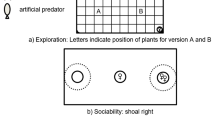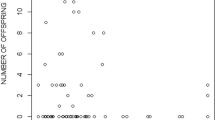Abstract
While behavioural plasticity is considered an adaptation to fluctuating social and environmental conditions, many animals also display a high level of individual consistency in their behaviour over time or across contexts (generally termed ‘personality’). However, studies of animal personalities that include sexual behaviour, or functionally distinct but correlated traits, are relatively scarce. In this study, we tested for individual behavioural consistency in courtship and exploratory behaviour in male guppies (Poecilia reticulata) in two light environments (high vs. low light intensity). Based on previous work on guppies, we predicted that males would modify their behaviour from sneak mating tactics to courtship displays under low light conditions, but also that the rank orders of courtship effort would remain unchanged (i.e. highly sexually active individuals would display relatively high levels of courtship under both light regimes). We also tested for correlations between courtship and exploratory behaviour, predicting that males that had high display rates would also be more likely to approach a novel object. Although males showed significant consistency in their exploratory and mating behaviour over time (1 week), we found no evidence that these traits constituted a behavioural syndrome. Furthermore, in contrast to previous work, we found no overall effect of the light environment on any of the behaviours measured, although males responded to the treatment on an individual-level basis, as reflected by a significant individual-by-environment interaction. The future challenge is to investigate how individual consistency across different environmental contexts relates to male reproductive success.

Similar content being viewed by others
References
Archard GA, Cuthill IC, Partridge JC (2009) Light environment and mating behavior in Trinidadian guppies (Poecilia reticulata). Behav Ecol Sociobiol 64(2):169–182. doi:10.1007/s00265-009-0834-2
Baerends GB, Brouwer R, Waterbolk HT (1955) Ethological studies in Lebistes reticulatus (Peters). I Anal Male Courtship Pattern Behav 8:249–335
Barlow GW (1968) Dither—a way to reduce undesirable fright behaviour in ethological studies. A Tierpsychol 25:315–318
Bates D, Maechler M (2009) lme4: linear mixed-effects models using S4 classes. R package version 0.999375-32.
Becker WA (1984) A manual of quantitative genetics. Academice Enterprises, Pullman
Bell AM (2005) Behavioral differences between individuals and two populations of stickleback (Gasterosteus aculeatus). J Evol Biol 18:464–473
Bell AM, Hankison SJ, Laskowski KL (2009) The repeatability of behaviour: a meta-analysis. Anim Behav 77(4):771–783. doi:10.1016/j.anbehav.2008.12.022
Blackwell PRY, Jennions MD, Christy JH, Passmore NI (1999) Female choice in the synchronously waving fiddler crab Uca annulipes. Ethology 105:415–421
Both C, Dingemanse NJ, Drent PJ, Tinbergen JM (2005) Pairs of extreme avian personalities have highest reproductive success. J Anim Ecol 74(4):667–674. doi:10.1111/j.1365-2656.2005.00962.x
Bretman A, Gage MJG, Chapman T (2011) Quick-change artists: male plastic behavioural responses to rivals. Trends Ecol Evol 26(9):467–473. doi:10.1016/j.tree.2011.05.002
Bretman A, Westmancoat JD, Gage MJG, Chapman T (2012) Individual plastic responses by males to rivals reveal mismatches between behaviour and fitness outcomes. Proc R Soc B-Biol Sci 279(1739):2868–2876. doi:10.1098/rspb.2012.0235
Brooks R, Endler JA (2001) Female guppies agree to differ: phenotypic and genetic variation in mate-choice behaviour and the consequences for sexual selection. Evolution 55:1644–1655
Budaev SV, Zworykin DD, Mochek AD (1999) Individual differences in parental care and behaviour profile in the convict cichlid: a correlational study. Anim Behav 58:195–202
Chapman BB, Morrell LJ, Krause J (2009) Plasticity in male courtship behaviour as a function of light intensity in guppies. Behav Ecol Sociobiol 63(12):1757–1763. doi:10.1007/s00265-009-0796-4
Coleman K, Wilson DS (1998) Shyness and boldness in pumpkinseed sunfish: individual differences are context-specific. Anim Behav 56:927–936. doi:10.1006/anbe.1998.0852
Colleter M, Brown C (2011) Personality traits predict hierarchy rank in male rainbowfish social groups. Anim Behav 81:1231–1237
Dall RX, Houston AI, McNamara JM (2004) The behavioural ecology of personality: consistent individual differences from an adaptive perspective. Ecol Lett 7:734–739. doi:10.1111/j.1461-0248.2004.00618.x
Dall SRX, Bell AM, Bolnick DI, Ratnieks FLW (2012) An evolutionary ecology of individual differences. Ecol Lett 15(10):1189–1198. doi:10.1111/j.1461-0248.2012.01846.x
Devigili A, Kelley JL, Pilastro A, Evans JP (2012) Expression of pre- and postcopulatory traits under different dietary conditions in guppies. Behav Ecol 24:740–749. doi:10.1093/beheco/ars204
DeWitt TJ, Sih A, Wilson DS (1998) Costs and limits of phenotypic plasticity. Trends Ecol Evol 13:77–81
Dill LM (1987) Animal decision making and its ecological consequences: the future of aquatic ecology and behaviour. Can J Zool 65:803–811
Dingemanse NJ, Reale D (2005) Natural selection and animal personality. Behaviour 142:1165–1190
Dingemanse NJ, Wolf M (2010) Recent models for adaptive personality differences: a review. Philos Trans R Soc B-Biol Sci 365(1560):3947–3958. doi:10.1098/rstb.2010.0221
Dingemanse NJ, Wolf M (2013) Between-individual differences in behavioural plasticity within populations: causes and consequences. Anim Behav 85(5):1031–1039. doi:10.1016/j.anbehav.2012.12.032
Dingemanse NJ, Both C, Drent PJ, Tinbergen JM (2004) Fitness consequences of avian personalities in a fluctuating environment. Proc R Soc B-Biol Sci 271:847–852. doi:10.1098/rspb.2004.2680
Dingemanse NJ, Kazem AJN, Reale D, Wright J (2010) Behavioural reaction norms: animal personality meets individual plasticity. Trends Ecol Evol 25:81–89
Endler JA (1987) Predation, light intensity and courtship behavior in Poecilia reticulata (Pisces: Poeciliidae). Anim Behav 35:1376–1385
Endler JA (1995) Multiple-trait coevolution and environmental gradients in guppies. TREE 10:22–29
Evans JP (2010) Quantitative genetic evidence that males trade attractiveness for ejaculate quality in guppies. Proc R Soc B-Biol Sci 277:3195–3201
Evans JP, Kelley JL, Ramnarine IW, Pilastro A (2002) Female behaviour mediates male courtship under predation risk in the guppy (Poecilia reticulata). Behav Ecol Sociobiol 52:496–502
Farr JA (1980) Social behaviour patterns as determinants of reproductive success in the guppy, Poecilia reticulata Peters (Pisces, Poeciliidae)—an experimental study of the effects of intermale competition, female choice, and sexual selection. Behaviour 74:38–91. doi:10.1163/156853980x00311
Gamble S, Lindholm AK, Endler JA, Brooks R (2003) Environmental variation and the maintenance of polymorphism: the effect of ambient light spectrum on mating behaviour and sexual selection in guppies. Ecol Lett 6(5):463–472
Godin JGJ, Dugatkin LA (1996) Female mating preference for bold males in the guppy, Poecilia reticulata. Proc Natl Acad Sci U S A 93(19):10262–10267. doi:10.1073/pnas.93.19.10262
Guevara-Fiore P (2012) Early social experience significantly affects sexual behaviour in male guppies. Anim Behav 84(1):191–195. doi:10.1016/j.anbehav.2012.04.031
Houde AE (1997) Sex, colour, and mate choice in guppies. Princeton University Press, Princeton
Huntingford FA (1976) The relationship between antipredator behaviour and aggression among conspecifics in the three-spined stickleback. Anim Behav 24:245–260
Jordan LA, Brooks RC (2012) Recent social history alters male courtship preferences. Evolution 66(1):280–287. doi:10.1111/j.1558-5646.2011.01421.x
Kats LB, Dill LM (1998) The scent of death: chemosensory assessment of predation risk by prey animals. Ecoscience 5:361–394
Kodric-brown A (1993) Female choice of multiple male criteria in guppies—interacting effects of dominance, coloration and courtship. Behav Ecol Sociobiol 32(6):415–420
Kodric-brown A, Nicoletto PF (1997) Repeatability of female choice in the guppy: response to live and videotaped males. Anim Behav 54:369–376
Kokko H, Rankin DJ (2006) Lonely hearts or sex in the city? Density-dependent effects in mating systems. Philos Trans R Soc B-Biol Sci 361(1466):319–334. doi:10.1098/rstb.2005.1784
Lessells CM, Boag PT (1987) Unrepeatable repeatabilities: a common mistake. Auk 104:116–121
Liley NR (1966) Ethological isolating mechanisms in four sympatric species of poeciliid fishes. Behav (Supplement XIII) 13:1–197
Lima SL (1998) Stress and decision making under the risk of predation: recent developments from behavioral, reproductive, and ecological perspectives. Adv Study Anim Behav 27:215–290
Lindholm AK, Breden F, Alexander HJ, Chan WK, Thakurta SG, Brooks R (2005) Invasion success and genetic diversity of introduced populations of guppies Poecilia reticulata in Australia. Mol Ecol 14:3671–3682
Logue DM, Mishra S, McCaffrey D, Ball D, Cade WH (2009) A behavioral syndrome linking courtship behavior toward males and females predicts reproductive success from a single mating in the hissing cockroach, Gromphadorhina portentosa. Behav Ecol 20(4):781–788. doi:10.1093/beheco/arp061
Long KD, Houde AE (1989) Orange spots as a visual cue for female mate choice in the guppy (Poecilia reticulata). Ethology 82:316–324
Magellan K, Magurran AE (2007) Behavioral profiles: individual consistency in male mating behaviour under varying sex ratios. Anim Behav 74:1545–1550
Magurran AE (2005) Evolutionary ecology: the Trinidadian guppy. Oxford University Press, Oxford
Magurran AE, Seghers BH (1990) Risk sensitve courtship in the guppy (Poecilia reticulata). Behaviour 112:194–201
Martin JGA, Nussey DH, Wilson AJ, Réale D (2011) Measuring individual differences in reaction norms in field and experimental studies: a power analysis of random regression models. Methods Ecol Evol 2(4):362–374. doi:10.1111/j.2041-210X.2010.00084.x
Mason G, Burn CC, Dallaire JA, Kroshko J, Kinkaid HM, Jeschke JM (2013) Plastic animals in cages: behavioural flexibility and responses to captivity. Anim Behav 85(5):1113–1126. doi:10.1016/j.anbehav.2013.02.002
Mathot KJ, Wright J, Kempenaers B, Dingemanse NJ (2012) Adaptive strategies for managing uncertainty may explain personality-related differences in behavioural plasticity. Oikos 121:1009–1020
R Development Core Team (2012) A language and environment for statistical computing. R Foundation for Statistical Computing, Austria
Rahman MM, Kelley JL, Evans JP (2013) Condition-dependent expression of pre- and postcopulatory sexual traits in guppies. Ecol Evol 3(7):2197–2213. doi:10.1002/ece3.632
Réale D, Reader SM, Sol D, McDougall PT, Dingemanse NJ (2007) Integrating animal temperament within ecology and evolution. Biol Rev 82(2):291–318. doi:10.1111/j.1469-185X.2007.00010.x
Reaney LT, Backwell PRY (2007) Risk-taking behavior predicts aggression and mating success in a fiddler crab. Behav Ecol 18(3):521–525. doi:10.1093/beheco/arm014
Relyea RA (2001) Morphological and behavioral plasticity of larval anurans in response to different predators. Ecology 82(2):523–540. doi:10.1890/0012-9658(2001)082[0523:mabpol]2.0.co;2
Relyea RA (2002) Costs of phenotypic plasticity. Am Nat 159(3):272–282. doi:10.1086/338540
Reynolds JD, Gross MD, Coombs MJ (1993) Environmental conditions and male morphology determine alternative mating behaviour in Trinidadian guppies. Anim Behav 45(1):145–152
Riechert SE, Hedrick AV (1993) A test for correlations among fitness-linked behavioral traits in the spider Agelenopsis aperta (Araneae, Agelenidae). Anim Behav 46(4):669–675. doi:10.1006/anbe.1993.1243
Schuett W, Tregenza T, Dall SRX (2010) Sexual selection and animal personality. Biol Rev 85:217–246
Schuett W, Dall SRX, Royle NJ (2011) Pairs of zebra finches with similar ‘personalities’ make better parents. Anim Behav 81(3):609–618. doi:10.1016/j.anbehav.2010.12.006
Sih A, Bell AM (2008) Insights for behavioral ecology from behavioral syndromes. Adv Study Behav 38:227–281
Sih A, Bell A, Johnson JC (2004a) Behavioral syndromes: an ecological and evolutionary overview. TREE 19:372–378
Sih A, Bell A, Johnson JC, Ziemba R (2004b) Behavioral syndromes: an integrative overview. Q Rev Biol 79:241–277
Smith BR, Blumstein DT (2010) Behavioral types as predictors of survival in Trinidadian guppies (Poecilia reticulata). Behav Ecol 21(5):919–926. doi:10.1093/beheco/arq084
Stoner G, Breden F (1988) Phenotypic differentiation in female preference related to geographic variation in male predation risk in the Trinidad guppy (Poecilia reticulata). Behav Ecol Sociobiol 22(4):285–291. doi:10.1007/bf00299844
Tollrian R, Harvell D (1999) The ecology and evolution of inducible defences. Princeton University Press, Princeton
van de Pol M, Wright J (2009) A simple method for distinguishing within- versus between-subject effects using mixed models. Anim Behav 77(3):753–758. doi:10.1016/j.anbehav.2008.11.006
Via S, Gomulkiewicz R, De Jong G, Scheiner SM, Schlichting CD, Van Tienderen PH (1995) Adaptive phenotypic plasticity: consensus and controversy. Trends Ecol Evol 10(5):212–217. doi:10.1016/S0169-5347(00)89061-8
West-Eberhard MJ (1989) Phenotypic plasticity and the origins of diversity. Ann Rev Ecol Syst 20:249–278
Acknowledgments
We are grateful to Cameron Duggin for assistance with maintenance and fish care and Joe Tomkins and Tom Pizzari for discussion. We also thank Ben Chapman and the anonymous reviewers whose comments greatly improved this paper. We also acknowledge the Universities of Western Australia and Oxford, and the Australian Research Council, for financial support.
Ethical standards
These experiments were conducted according to the Australian Code of Practice for the Care and Use of Animals for Scientific Purposes and were approved by the Animal Ethics Committee of The University of Western Australia (approval number: RA/3/100/513).
Conflict of interest
The authors declare that they have no conflict of interest.
Author information
Authors and Affiliations
Corresponding author
Additional information
Communicated by: Sven Thatje
Rights and permissions
About this article
Cite this article
Kelley, J.L., Phillips, S.C. & Evans, J.P. Individual consistency in exploratory behaviour and mating tactics in male guppies. Naturwissenschaften 100, 965–974 (2013). https://doi.org/10.1007/s00114-013-1097-3
Received:
Revised:
Accepted:
Published:
Issue Date:
DOI: https://doi.org/10.1007/s00114-013-1097-3




